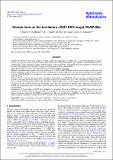Clouds form on the hot Saturn JWST ERO target WASP-96b
Abstract
Context. WASP-96b is a hot Saturn exoplanet, with an equilibrium temperature of ≈ 1300 K. This is well within the regime of thermodynamically expected extensive cloud formation. Prior observations with Hubble/WFC3, Spitzer/IRAC, and VLT/FORS2 have been combined into a single spectrum for which retrievals suggest a cold but cloud-free atmosphere. Recently, the planet was observed with the James Webb Space Telescope (JWST) as part of the Early Release Observations (ERO). Aims. The formation of clouds in the atmosphere of exoplanet WASP-96b is explored. Methods. One-dimensional profiles were extracted from the 3D GCM expeRT/MITgcm results and used as input for a kinetic, non-equilibrium model to study the formation of mineral cloud particles of mixed composition. The ARCiS retrieval framework was applied to the pre-JWST WASP-96b transit spectrum to investigate the apparent contradiction between cloudy models and assumed cloud-free transit spectrum. Results. Clouds are predicted to be ubiquitous throughout the atmosphere of WASP-96b. Silicate materials contribute between 40% and 90% cloud particle volume, which means that metal oxides also contribute with up to 40% cloud particle volume in the low-pressure regimes that affect spectra. We explore how these cloudy models match currently available transit spectra. Reduced vertical mixing acts to settle clouds to deeper in the atmosphere, and an increased cloud particle porosity reduces the opacity of clouds in the near-IR and optical region. These two effects allow for clearer molecular features to be observed while still allowing clouds to be in the atmosphere. Conclusions. The atmosphere of WASP-96b is unlikely to be cloud free. Retrievals of HST, Spitzer, and VLT spectra also show that multiple cloudy solutions reproduce the data. JWST observations will be affected by clouds, where the cloud top pressure varies by an order of magnitude within even the NIRISS wavelength range. The long-wavelength end of NIRSpec and the short-wavelength end of MIRI may probe atmospheric asymmetries between the limbs of the terminator on WASP-96b.
Citation
Samra , D , Helling , C , Chubb , K , Min , M , Carone , L & Schneider , A 2023 , ' Clouds form on the hot Saturn JWST ERO target WASP-96b ' , Astronomy & Astrophysics , vol. 669 , A142 . https://doi.org/10.1051/0004-6361/202244939
Publication
Astronomy & Astrophysics
Status
Peer reviewed
ISSN
0004-6361Type
Journal article
Description
Funding: Ch.H., M.M., L.C., and A.D.S. acknowledge funding from the European Union H2020-MSCA-ITN-2019 under Grant Agreement no. 860470 (CHAMELEON). K.L.C. acknowledges funding from STFC, under project number ST/V000861/1. D.S. acknowledges financial support from the Austrian Academy of Science.Collections
Items in the St Andrews Research Repository are protected by copyright, with all rights reserved, unless otherwise indicated.
Related items
Showing items related by title, author, creator and subject.
-
Precise masses in the WASP-47 system
Vanderburg, Andrew; Becker, Juliette C.; Buchhave, Lars A.; Mortier, Annelies; Lopez, Eric; Malavolta, Luca; Haywood, Raphaëlle D.; Latham, David W.; Charbonneau, David; López-Morales, Mercedes; Adams, Fred C.; Bonomo, Aldo Stefano; Bouchy, François; Collier Cameron, Andrew; Cosentino, Rosario; Di Fabrizio, Luca; Dumusque, Xavier; Fiorenzano, Aldo; Harutyunyan, Avet; Johnson, John Asher; Lorenzi, Vania; Lovis, Christophe; Mayor, Michel; Micela, Giusi; Molinari, Emilio; Pedani, Marco; Pepe, Francesco; Piotto, Giampaolo; Phillips, David; Rice, Ken; Sasselov, Dimitar; Ségransan, Damien; Sozzetti, Alessandro; Udry, Stéphane; Watson, Chris (2017-11-17) - Journal articleWe present precise radial velocity observations of WASP-47, a star known to host a hot Jupiter, a distant Jovian companion, and, uniquely, two additional transiting planets in short-period orbits: a super-Earth in a ≈19 ... -
Three newly discovered sub-Jupiter-mass planets : WASP-69b and WASP-84b transit active K dwarfs and WASP-70Ab transits the evolved primary of a G4+K3 binary
Anderson, D. R.; Cameron, A. Collier; Delrez, L.; Doyle, A. P.; Faedi, F.; Fumel, A.; Gillon, M.; Chew, Y. Gomez Maqueo; Hellier, C.; Jehin, E.; Lendl, M.; Maxted, P. F. L.; Pepe, F.; Pollacco, D.; Queloz, D.; Segransan, D.; Skillen, I.; Smalley, B.; Smith, A. M. S.; Southworth, J.; Triaud, A. H. M. J.; Turner, O. D.; Udry, S.; West, R. G. (2014-12-01) - Journal articleWe report the discovery of the transiting exoplanets WASP-69b, WASP-70Ab and WASP-84b, each of which orbits a bright star (V ∼ 10). WASP-69b is a bloated Saturn-mass planet (0.26 MJup, 1.06 RJup) in a 3.868-d period around ... -
The well-aligned orbit of Wasp-84b : evidence for disk migration of a hot Jupiter
Anderson, D. R.; Triaud, A. H. M. J.; Turner, O. D.; Brown, D. J. A.; Clark, B. J. M.; Smalley, B.; Cameron, A. Collier; Doyle, A. P.; Gillon, M.; Hellier, C.; Lovis, C.; Maxted, P. F. L.; Pollacco, D.; Queloz, D.; Smith, A. M. S. (2015-02-10) - Journal articleWe report the sky-projected orbital obliquity (spin–orbit angle) of WASP-84 b, a 0.69 planet in an 8.52 day orbit around a G9V/K0V star, to be λ = −0.3 ± 1.7°. We obtain a true obliquity of ψ = 17.3 ± 7.7° from a measurement ...

